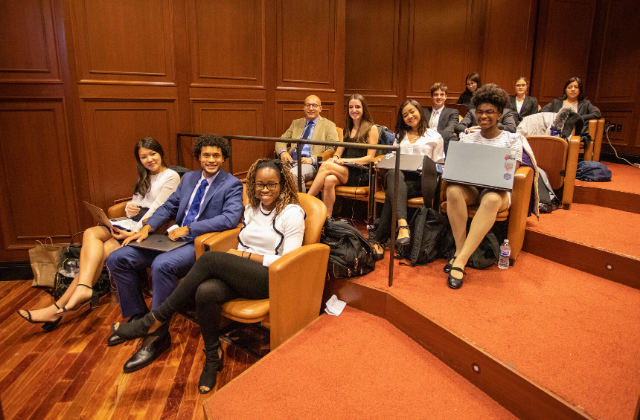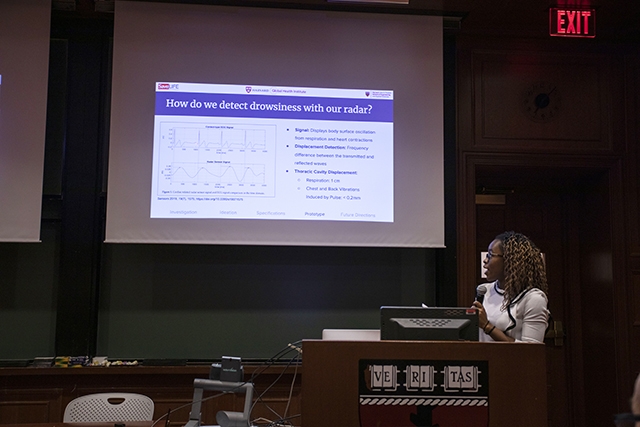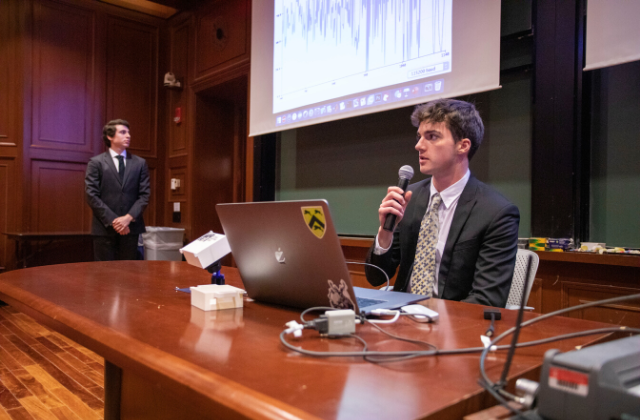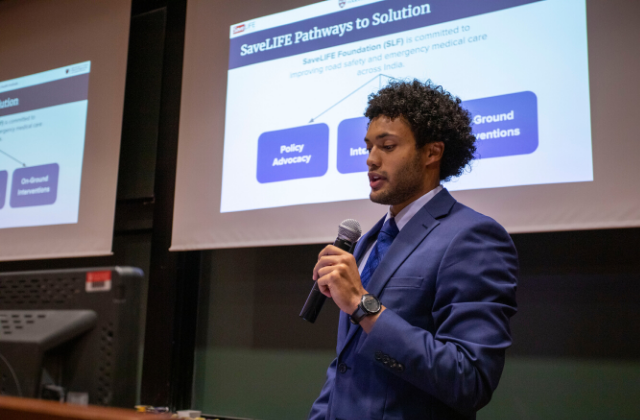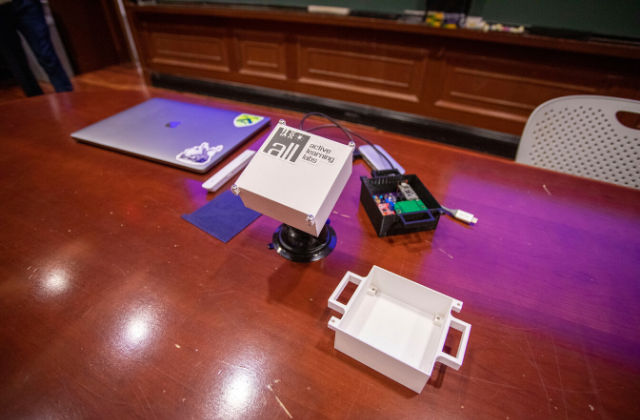News
These students collaborated to develop a drowsiness detection device that monitors a driver’s vital signs and sounds an alarm if he or she is in danger of falling asleep behind the wheel. (Photo courtesy of the Harvard Global Health Institute)
Traffic accidents throughout India claimed the lives of more than 150,000 people in 2016, according to the SaveLIFE Foundation. The nation’s road safety crisis continues to worsen, with the number of fatalities increasing steadily over the last decade.
To help reverse this deadly trend, a team of Harvard John A. Paulson School of Engineering and Applied Sciences students joined forces with the SaveLife Foundation and Harvard Global Health Institute for their group project in Engineering Problem Solving and Design Project (ES 96.) The course, taught by David Mooney, Robert P. Pinkas Family Professor of Bioengineering, challenges students to use engineering design skills to create a solution for a real-world client.
“One of the biggest challenges we faced was being tasked with such a broad and complex problem, that of road safety in India, and having to refine our ideas and analysis in a methodical and quantitative way,” said Jessica DeVilla, S.B. ’21, a bioengineering concentrator. “Through extensive research, we learned about the problem space from the perspectives of law enforcement, bystanders, victims, emergency responders, engineers, and more.”
Project co-lead Nina Uzoigwe S.B. ’21, a bioengineering concentrator explains how the students' drowsiness detection device works. (Photo courtesy of the Harvard Global Health Institute)
Drawing on that analysis, the students zeroed in on one particular issue: crashes caused by driver fatigue. They developed a drowsiness detection device that monitors a driver’s vital signs and sounds an alarm if he or she is in danger of falling asleep behind the wheel.
Using radar, the device monitors heart rate and applies an algorithm that incorporates values for heart rate variability (the variation in time between each heartbeat) over time. When the variability is altered beyond an established threshold, the device sounds an alarm, explained DeVilla, who led the signal processing sub-team.
“The biggest challenge we encountered was simply dealing with the raw signal from our radar module,” said Alex Wulff, S.B. ’21, an electrical engineering concentrator who led the circuitry sub-team. “We spent a lot of time tinkering with the amplification circuitry to yield results that we were happy with. Our device needed to be as sensitive as possible in order to pick up heart rate, but not so sensitive that the slightest motions disrupted the signal.”
The students also faced challenges to design an effective housing for the electronic components, since the temperature inside a car could quickly reach 170 degrees Fahrenheit during India’s blistering pre-monsoon season.
Alex Wulff, S.B. ’21, an electrical engineering concentrator, demos the students' device during their final presentation. (Photo courtesy of the Harvard Global Health Institute)
“One of the biggest challenges for the mechanical sub-team was the device placement within the cabin of the vehicle. We were using non-contact based vital sign detection with the radar, so the most crucial aspect became placing the device as close as possible to the driver without in any way interfering with their normal driving motions or their line of sight,” said Sebastian Lindner-Liaw, S.B. ’21, a mechanical engineering concentrator and leader of the mechanical sub-team. “We wanted to place the device in a location where the driver would never accidentally knock it over.”
They designed a car seat strap that positions the device behind the driver and also an adjustable suction cup mount that could be installed on a dashboard or windshield.
The students also kept a close eye on costs; the prototype is compatible with a wide range of vehicles and costs less than $30 to produce. Affordability is critical when creating a solution for a low- or middle-income country like India, where the average person earns $616 per year.
“The most surprising thing I learned over the course of this class is how difficult it can be to try to create a solution for an area of the world that you aren't extremely familiar with,” said project co-lead Kahlil Wassell, S.B. ’21, a mechanical engineering concentrator. “Being unfamiliar with the culture, customs, and the infrastructure of a country can make it much more challenging.”
Project co-lead Kahlil Wassell, S.B. ’21, a mechanical engineering concentrator, describes how the students developed the idea for their solution. (Photo courtesy of the Harvard Global Health Institute)
With a working prototype in hand, the team would like to continue refining their project by comparing alternative algorithms, conducting more testing, and standardizing the device placement.
“I had no idea what direction their solutions and design would take them at the beginning of the semester, but the students did a great job researching the problem and identifying a very creative way to address it,” said Mooney. “Hopefully they learned the value of digging deep into a topic to really understand the underlying issues and appreciate the cultural aspects of any solutions they may propose, and the importance of teamwork to get a big project successfully completed.”
The SaveLIFE Foundation has offered to pilot the device on 100 truck drivers who frequently travel the Mumbai Pune Expressway, a six-lane superhighway that is one of India’s busiest roads.
“With our partner, the SaveLIFE Foundation, we challenged the students to think about how to apply engineering to solve complicated global health challenges like road traffic incidents, the leading cause of death of young people around the world, in a country more than 7,000 miles away. Cultural, political, and economic constraints had also tested them at every step of the design process,” said Kelly Phouyaphone, program manager for HGHI’s initiatives in climate change and health and healthy cities. “So we were blown away by what the students presented in just four months to address drivers falling asleep at the wheel, one of the major causes behind road traffic incidents, and hope that they continue to engage with SaveLIFE to one day make the device a reality to all drivers.”
For project co-lead Nina Uzoigwe S.B. ’21, a bioengineering concentrator, working on a solution that could save thousands of lives was a gratifying experience.
The team would like to continue refining this prototype by comparing alternative algorithms, conducting more testing, and standardizing the device placement. (Photo courtesy of the Harvard Global Health Institute)
“As the issue of road crashes in India becomes increasingly dire, ushering in an effective solution becomes all the more urgent and necessary. The call to address this perpetual issue grows even louder in light of India’s recent population growth, which increases the rate of motorization as well as the amount of foot traffic found within the mixed modality travel seen today in India’s roads and highways,” she said. “We were able to accomplish our outlined goals, creating a proof of concept where one can use a radar module to extract vital sign information, specifically heart rate variability, to detect drowsiness. I could not be prouder to have worked so closely with such an intellectually driven team.”
Topics: Academics
Cutting-edge science delivered direct to your inbox.
Join the Harvard SEAS mailing list.
Press Contact
Adam Zewe | 617-496-5878 | azewe@seas.harvard.edu
